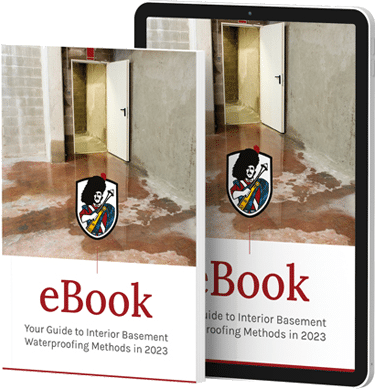The leaves are starting to change in the Greater Toronto Area, and while beautiful, it also means danger for your home and foundation. Colder temperatures mean the season’s first frost is coming. If unprepared, either of these natural events can cause a significant increase in the moisture on and around your home, potentially damaging your foundation, walls, and roof. At GJ MacRae, we’re very familiar with these dangers and know how to protect your home from being impacted by cold weather changes.
Leaf Fall
Leaf fall is when all the leaves come off the trees and cover the ground and nearby structures. While this period of time is visually stunning, it can also spell danger for your home.
Leaves are moisture-absorbent and can stay wet for a long time. When rain causes more leaves to fall or hits the leaves already on the ground, it can cause a prolonged period of moisture to sit on your soil, foundation, and roof.
Saturating your roof or foundation with water is an obvious problem, but the increased moisture in the soil is also a significant sign of danger. If your foundation is not adequately waterproofed when this happens, you are likely to spring a leak or start the mold/rot process in your home.
Adequate drainage, proper grade and good runoff around your structure are essential in preventing this.
First Frost
Transitional seasons are very dangerous because, hot or cold, your structure wants to remain at one temperature on the outside. When you heat glass and immediately transfer it somewhere cold, or take a cold glass and transfer it somewhere very hot, it will crack. The same is true of your foundation without adequate winterizing and waterproofing.
Frost is usually only present for a single night or a morning, making it a significant danger to your home as the world around it rapidly thaws, and your foundation is still cold.
What You Should Look For
Clogged Gutters & Frozen Water Lines
As leaves fall off the trees, they get stuck in our homes’ gutters, clogging them for the rest of the winter. Clogs are hazardous, as having a clear runoff source is essential to protect your roof, walls, and foundation. Otherwise, the water has nowhere to go and can impact the stability of your home’s waterproofing.
Likewise, if you have a sump pump or other drainage system, without proper winterizing, there is a chance the output line will freeze, leaving you without the water drainage you installed it for.
When your waterproofing is impacted during the winter, mold or rot may take root in your home without you noticing. Make sure your gutters are clear of debris and that you have a clear runoff plan for moisture accumulating on your home during the winter.
Roof Damage
Leaves absorb moisture easily and stay wet for a long time. If leaves accumulate on your roof for too long, then your shingles can store the water into your roof and impact the structural soundness of your home.
This is also an excellent reason to have your roof freshly waterproofed before the winter so that the impact of this moisture is minimized.
Foundation Damage
Most dangerously, if you have not adequately prepared your home for winter, you may find a crack in your foundation before the snow melts! During the winter, there is increased pressure on your foundation from the weight of the snow and prolonged exposure to moisture as it sits on your foundation.
Throughout winter, your home is subject to what is known as a freeze-thaw cycle, where the weather shifts around freezing temperatures, and the layer of moisture on the grounds changes forms. This quick change of freezing and thawing can cause an unprepared home’s foundation to shift, resulting in cracks and leaks.
A crack quickly becomes significant structural damage in a home’s foundation, can lose you a lot of money on heating expenses, and threaten your family. Likewise, a crack will leak if there is too much moisture around the home, allowing rot to start invading your house.
On top of the impact of winter during the season, there’s also the impact of melt when Spring starts. If moisture is already making its way into your basement in the winter, you will likely have a flood when warmer weather rolls around.
An excellent way to prepare for this is to have your basement waterproofed by someone who knows the standard winter conditions of your area, like GJ MacRae. With expert knowledge in tow, it’s easy to make sure your home will hold up against winter weather.
Drafts and Leaks from Doors
If left unattended, that gap of light from your back door will continue to leak cold air and moisture into your home. It’s hard to keep water off your floors in the winter season, but if it comes through your door, it’s far worse.
Often, these leaks are not noticed immediately and can create a spot of wear in the home that degrades faster than in other areas.







